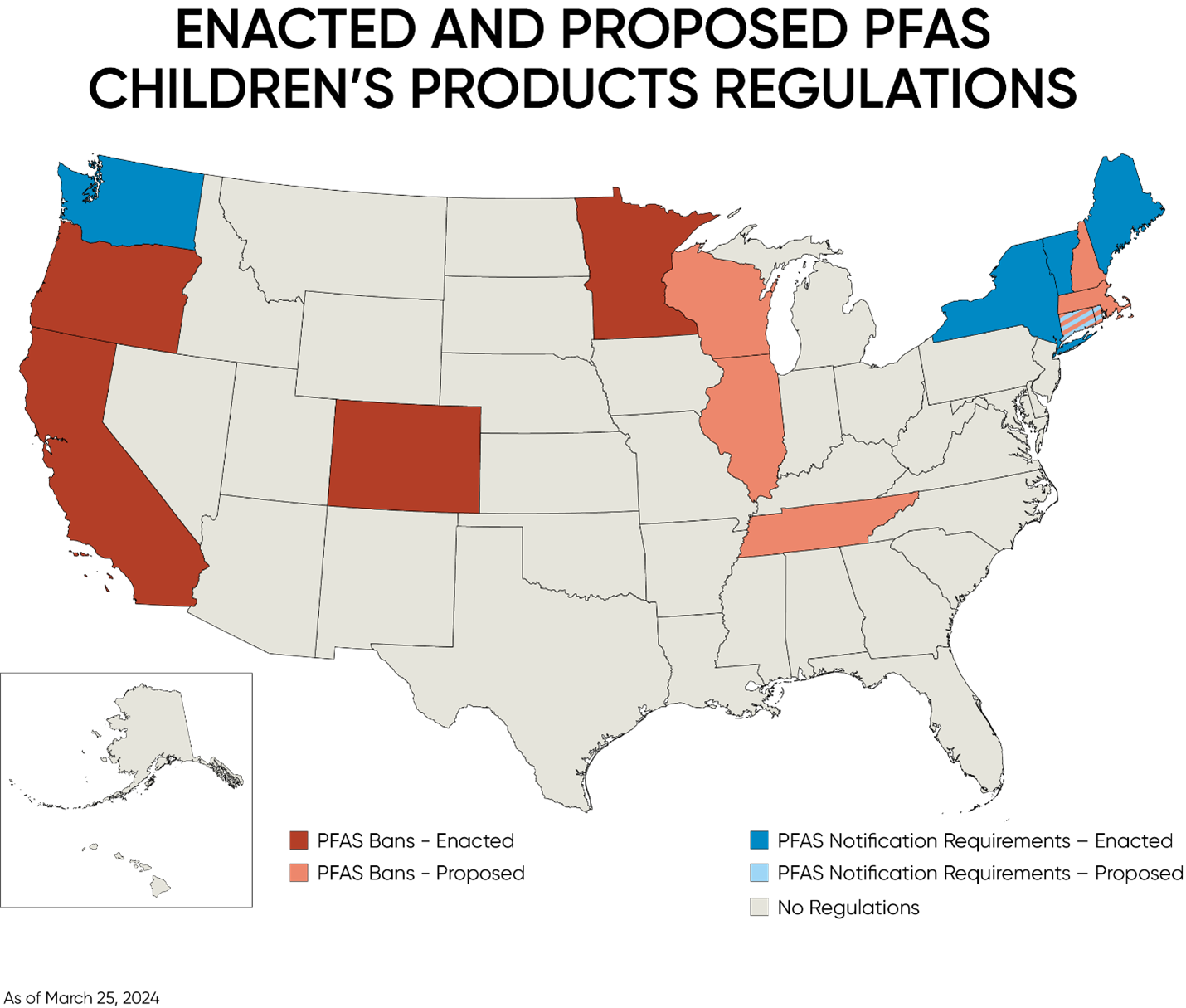BCLPemerging.com
PFAS in children’s products: state-by-state regulations
Updated: March 2024
Mar 27, 2024Summary
PFAS in Children’s Products is a major focus for state legislators across the country, prompting some of the most stringent PFAS restrictions in consumer products. Thus far, eight states have enacted legislation concerning PFAS substances in Children’s or Juvenile Products (“Children’s Products”). Seven additional states have proposed Children’s Products laws, and many of these are expected to continue to move through the legislative process in future months.
There are numerous key features that are generally consistent across the state laws:
- “Juvenile products” are generally defined as products that are intended for use by children 12 years old or younger.
- The prohibitions apply to “intentionally added” PFAS, which generally are PFAS added to a product to create a specific effect in the finished product.
- The compliance timelines are much shorter than the timelines for other types of consumer products that are being regulated for the presence of intentionally added PFAS.
- Some, but not all, of the laws exempt internal components of the product that are not accessible during foreseeable “use and abuse” of the product.
Perhaps the biggest challenge posed by these laws is that unlike other PFAS laws which apply to a specific industry category (e.g., cookware, cosmetics, apparel), they apply across all consumer product categories, making them more difficult for impacted businesses to track.
State Regulations
The map below shows the states that have enacted or proposed laws regarding Children’s Products, and we have also included descriptions which provide more information on the specific provisions of those laws. Because the regulation of Children’s Products is developing, it is important to note that this client alert reflects the status of state legislation regarding PFAS in Children’s Products as of March 25, 2024.

PFAS Bans - Enacted |
Children's products descriptions
Effective currently, a person, including a manufacturer, shall not sell or distribute any new juvenile product that contains regulated PFAS chemicals. A manufacturer shall use the least toxic alternative when replacing PFAS chemicals in a juvenile product.
“Regulated PFAS” means either of the following:
- PFAS that has been intentionally added to a product that creates either a functional or technical effect.
- The presence of PFAS in a product is at or above 100 ppm, as measured in total organic fluorine.
“Juvenile product” means a product designed for use by infants or children under 12 years of age, including, but not limited to, a baby or toddler foam pillow, bassinet, bedside sleeper, booster seat, changing pad, child restraint system for use in motor vehicles and aircraft, co-sleeper, crib mattress, floor play mat, highchair, highchair pad, infant bouncer, infant carrier, infant seat, infant sleep positioner, infant swing, infant travel bed, infant walker, nap cot, nursing pad, nursing pillow, play mat, playpen, play yard, polyurethane foam mat, pad, or pillow, portable foam nap mat, portable infant sleeper, portable hook-on chair, soft-sided portable crib, stroller, and toddler mattress.
“Juvenile product” does not include the following things: (1) a children’s electronic product; (2) a medical device; (3) an internal component of a juvenile product that should not come into direct contact with a child’s skin or mouth; and (4) an adult mattress.
Regulatory status
Enacted – In effect on July 1, 2023
Details
Children's products descriptions
Beginning on January 1, 2024, a person shall not sell or distribute any juvenile product with intentionally added PFAS chemicals.
“Intentionally added” means PFAS chemicals that a manufacturer has added to a product that has created either a functional or technical effect on that product.
“Juvenile product” means a product designed for use by infants or children under 12 years of age, including bassinets and other bedside sleepers; booster seats, car seats, and other child restraint devices; changing pads; co-sleepers; crib or toddler mattresses; floor play mats; highchairs and highchair pads; infant bouncers; infant carriers; infant or toddler foam pillows; infant seats; infant sleep positioners; infant swings; infant travel beds; infant walkers; nap cots; nursing pads and pillows; play mats; playpens; play yards; polyurethane foam mats, pads, or pillows; portable foam nap mats; portable infant sleepers and hook-on chairs; soft-sided portable cribs; and strollers.
“Juvenile Product” does not include the following things: (1) electronic products; (2) an internal component of a juvenile product that should not come into direct contact with a child’s skin or mouth; and (3) an adult mattress.
Regulatory status
Enacted – In effect on January 1, 2024
Details
Children's products descriptions
Beginning on January 1, 2025, a person may not sell or distribute any juvenile product if the product contains intentionally added PFAS.
"Intentionally added" means PFAS deliberately added during the manufacture of a product where the continued presence of PFAS is desired in the final product or one of the product’s components to perform a specific function.
“Juvenile product" means a product designed or marketed for use by infants and children under 12 years of age, including but not limited to, a baby or toddler foam pillow; bassinet; bedside sleeper; booster seat; changing pad; child restraint system for use in motor vehicles and aircraft; co-sleeper; crib mattress; highchair; highchair pad; infant bouncer; infant carrier; infant seat; infant sleep positioner; infant swing; infant travel bed; infant walker; nap cot; nursing pad; nursing pillow; play mat; playpen; play yard; polyurethane foam mat, pad, or pillow; portable foam nap mat; portable infant sleeper; portable hook-on chair; soft-sided portable crib; stroller; and toddler mattress.
“Juvenile Product” does not include the following things: (1) a children's electronic product; or (2) an adult mattress.
Note: There are also lead and cadmium prohibitions for children’s jewelry.
Regulatory status
Enacted – In effect on January 1, 2025
Details
Children's products descriptions
Effective currently, a manufacturer of a children’s product sold or offered for sale that contains a chemical included on the High Priority List of Chemicals of Concern to Children in an amount above a de minimis level shall provide a notice to the Oregon Health Authority.
Effective currently, before the time when a manufacturer of a children’s product submits the third biennial notice (e.g., approximately six years after chemical listing), the manufacturer must remove or make a substitution if the chemical is present in a children’s product that is mouthable; a children’s cosmetic; or marketed to children under three years of age. Certain manufacturers are subject to exemptions.
PFOS and its salts are included as Chemicals of High Concern to children under the statute.
“Children’s product” is any of the following products that are made for children under 12 years of age: a product designed or intended by the manufacturer to facilitate sucking, teething, sleep, relaxation, feeding or drinking; children’s clothing and footwear; car seats; children’s cosmetics; children’s jewelry; and toys.
“Children’s Product” does not include the following things: (1) athletic shoes with cleats or spikes; (2) batteries; (3) BB guns, pellet guns, and air rifles; (4) bicycles and tricycles; (5) chemistry sets; (6) consumer electronic products; (7) interactive software intended for leisure and entertainment; (8) model rockets; (9) pocketknives and multitools; (10) roller skates; (11) scooters; (12) sets of darts with metallic points; (13) slings and catapults; (14) snow sporting equipment; (15) sporting equipment and accessories; (16) video toys that can be connected to a video screen and are operated by using more than 24 volts; and (17) food, beverages and related packaging regulated by the FDA or the USDA.
“De minimis level” is a chemical that is an intentionally added chemical, the practical quantification limit; or for a chemical that is a contaminant, a concentration of 100 ppm.
Regulatory status
Enacted - January 1, 2022, and approximately six years from the new chemical listing
Details
Oregon Secretary of State Information
PFAS notification requirements - enacted |
Children's products descriptions
Effective currently, manufacturers or distributors of the following children’s products that contain intentionally added amounts of PFOS or its salts must submit information to the Maine Department of Environmental Protection (“MDEP”): child care articles; clothing; footwear; sleepwear; toys; cookware, tableware, reusable food and beverage containers; cosmetics and personal care products; craft supplies; electronic devices; and household furniture and furnishings.
PFOS and its salts appear on the list of chemicals of high concern.
“Intentionally added” means a chemical that was added during the manufacture of a product to provide a specific characteristic, appearance or quality, or to perform a specific function.
“Children’s product” means a consumer product intended for children under 12 years of age, such as baby products, toys, car seats, personal care products and clothing, and any consumer product containing a chemical of high concern that when used or disposed of will likely result in a child under 12 years of age or a fetus being exposed to that chemical.
Regulatory status
Enacted - July 28, 2020
Details
Children's products descriptions
Effective currently, every manufacturer who offers a children’s product for sale or distribution that contains a chemical of concern shall report to the New York Department of Environmental Conservation. This reporting does not apply to the sale or distribution of used products.
Chemicals of Concern includes: (1) PFOA and related substances; and (2) PFOS and its salts.
“Children’s Product” means a product intended for children, such as baby products; toys; car seats; school supplies; personal care products; a product designed or intended by the manufacturer to help a child with sucking or teething, to facilitate sleep, relaxation, or the feeding of a child; children’s novelty products; children’s jewelry; children’s bedding, furniture, furnishings, and apparel.
“Children’s Product” does not include the following things: (1) batteries; (2) consumer electronic products; (3) a food or beverage or an additive to a food and beverage regulated by the FDA; or (4) a drug, biologic, or medical device regulated by the FDA.
Regulatory status
Enacted - March 1, 2020
Details
Children's products descriptions
Effective currently, a manufacturer of a children’s product shall submit a notice for each chemical of high concern to the Vermont Department of Health if the chemical is: (1) intentionally added to a children’s product; or (2) present as a contaminant at a concentration of 100 ppm or greater.
Effective currently, state organizations may adopt a rule to regulate the sale or distribution of a children’s product containing a chemical of high concern if exposure to the chemical may cause or contribute to an adverse health impact.
Chemicals of High Concern include: PFOS and its salts, PFHxS, PFHpA, and PFNA.
“Children’s product” means any consumer product marketed or distributed to children including any of the following: toys; children’s cosmetics; a product designed or intended by the manufacturer to help a child with sucking or teething, to facilitate sleep, relaxation, or the feeding of a child, or to be worn as clothing by children; or child car seats.
“Children’s Product” does not include the following things: (1) batteries; (2) snow sporting equipment; and (3) inaccessible components of a consumer product that should not come into direct contact with a child’s skin or mouth.
“Intentionally added” means the addition of a chemical in a product that serves an intended function in the product component.
Regulatory status
Enacted - July 1, 2022
Details
Children's products descriptions
Effective currently, the manufacturer of a children's product sold or offered for sale that contains a chemical of high concern to children in an amount above a de minimis level must report information to the Washington Department of Health.
Chemicals of High Concern to Children include: PFOA and its salts and PFOS and its salts.
"Children's product" includes any of the following: toys; children's cosmetics; children's jewelry; a product designed or intended by the manufacturer to help a child with sucking or teething, to facilitate sleep, relaxation, or the feeding of a child, or to be worn as clothing by children; or portable infant or child safety seat designed to attach to an automobile seat.
“Children’s Product” does not include the following things: (1) over the counter drugs; (2) prescription drugs; (3) food; (4) dietary supplements; (5) packaging; (6) medical devices; (7) or products that are both a cosmetic and a drug regulated by the FDA.
"De minimis level" means for a chemical that is an intentionally added chemical, a concentration below the practical quantification limit; or for a chemical that is a contaminant, a concentration below 100 ppm.
"Intentionally added chemical" means a chemical in a product that serves an intended function in the product component.
Regulatory status
Enacted - August 21, 2011
PFOS was included originally in 2011 as a Chemical of High Concern to Children
Details
PFAS bans - proposed |
Children's products descriptions
Beginning on January 1, 2025, no person shall sell or distribute any juvenile product if the product contains an intentionally added PFAS chemical.
“Intentionally added PFAS chemical” means a PFAS deliberately added during the manufacture of a product or reasonably expected to be present.
“Juvenile product” means a product designed for use by infants or children under 12 years of age. Juvenile products includes, but is not limited to, the following: a baby or other toddler foam pillow; bassinet; bedside sleeper; booster seat; changing pad; child restraint system for use in a motor vehicle and aircraft; co-sleeper; crib mattress; highchair; highchair pad; infant bouncer; infant carrier; infant swing; infant travel bed; infant walker; nap cot; nursing pad; nursing pillow; play mat; playpens; play yard; polyurethane foam mat, pad, or pillow; portable foam nap mat; portable infant sleeper; portable hook-on chair; soft-sided portable crib; stroller; and toddler mattress
“Juvenile product” does not include the following things: (1) electric products; or (2) internal components of juvenile products that should not come into contact with a child’s skin or mouth.
Regulatory status
Proposed
Details
Children's products descriptions
No manufacturer, wholesaler or retailer shall sell or distribute for use a children’s product or product component containing regulated PFAS.
“Children’s product” means consumer products intended, made, or marketed for use by children 12 years of age or under, including the following: (i) toys; (ii) children’s clothing; (iii) children's cosmetics and personal care products; (iv) children's jewelry and novelty products; (v) children’s school supplies; (vi) children’s arts and crafts supplies, including model making supplies; (vii) children’s bedding, furniture, and furnishings; (viii) child car seats; (ix) products to help a child with sucking or teething, or to facilitate sleep, relaxation, or the feeding of a child; and (x) artificial turf fields installed on school properties, publicly owned properties, or intended for use by children under the age of 18.
“Children’s Product” does not include the following things: (1) batteries; (2) slings and catapults; (3) sets of darts with metallic points; (4) toy steam engines; (5) bicycles and tricycles; (6) video toys that can be connected to video screen and are operated using more than 24 volts; (7) chemistry sets; (8) consumer and children's electronic products; (9) interactive software intended for leisure and entertainment; (10) BB guns, pellet guns, and air rifles; (11) snow sporting equipment; (12) roller skates; (13) scooters; (14) model rockets; (15) athletic shoes with cleats or spikes; (16) pocketknives and multitools; (17) food and beverages regulated by the FDA or USDA; (18) pharmaceutical products and biologics; and (19) medical devices.
Regulatory status
Proposed Law I
Details
Children's products descriptions
Beginning on January 1, 2026, no manufacturer, distributor, wholesaler, or retailer shall sell or distribute children’s products to which PFAS have been intentionally added.
“Children’s products” means consumer products, including its product components, intended, made or marketed for use by children 12 years of age or under, not including medical devices.
“Intentionally added” means the addition of a chemical to a final product or product component for the purpose of providing a specific characteristic, appearance, or quality to perform a specific function in the product or product component, including PFAS that are intentional chemical breakdown products or derivatives of an added chemical that also have a specific function in the product or product component.
Regulatory status
Proposed Law II
Details
Children's products descriptions
Beginning on July 1, 2028, juvenile products containing PFAS substances shall be prohibited from being sold, used, or distributed for promotional purposes in New Hampshire.
“Juvenile product” means any product designed or marketed for use by infants and children under 12 years of age, including, but not limited, to a baby or toddler foam pillow; bassinet; bedside sleeper; booster seat; changing pad; child restraint system for use in motor vehicles and aircraft; co-sleeper; crib mattress; highchair; highchair pad; infant bouncer; infant carrier; infant seat; infant sleep positioner; infant swing; infant travel bed; infant walker; nap cot; nursing pad; nursing pillow; playmat; playpen; play-yard; polyurethane foam mat, pad or pillow; portable form nap mat; portable infant sleeper; portable hook-on chair; soft-sided portable crib, stroller, and toddler mattress.
“Juvenile product” does not include the following things: (1) children’s electronic products; (2) a medical device; or (3) an adult mattress.
Regulatory status
Proposed
Details
Children's products descriptions
Beginning on January 1, 2025, a person shall not manufacture, sell, distribute, or offer for use a children’s product that contains intentionally added PFAS substances.
"Intentionally added" means PFAS substances deliberately added during the manufacture of a product where the continued presence of PFAS substances is desired in the final package or packaging component to perform a specific function.
Regulatory status
Proposed
Details
Children's products descriptions
Beginning on January 1, 2028, no person may sell or distribute juvenile products if the product contains intentionally added PFAS.
“Juvenile product” means a product designed or marketed for use by infants
and children under the age of 12, but does not include certain electronic products.
Intentionally added PFAS" means PFAS that are deliberately added during the manufacture of a product where the continued presence of PFAS is desired in the final product to perform a specific function.
Regulatory status
Proposed
Details
PFAS notification requirements - proposed |
Children's products descriptions
Beginning on January 1, 2026, no person shall sell or distribute cookware products that contain intentionally added PFAS substances.
Beginning on January 1, 2027, each manufacturer of a product sold or distributed that contains intentionally added PFAS substances shall submit information to the Connecticut Commissioner of Energy and Environmental Protection. No person may sell or distribute any product that contains intentionally added PFAS substances if the manufacturer failed to provide the information required.
"Children's product" means a product designed for use by children under twelve years of age, including, but not limited to, a baby or toddler foam pillow; bassinet; bedside sleeper; booster seat; changing pad; child restraint system for use in motor vehicles and aircraft; co-sleeper; crib mattress; highchair; highchair pad; infant bouncer; infant carrier; infant seat; infant sleep positioner; infant swing; infant travel bed; infant walker; nap cot; nursing pad; nursing pillow; play mat; playpen; play yard; polyurethane foam mat, pad or pillow; portable foam nap mat; portable infant sleeper; portable hook on chair; soft-sided portable crib; stroller; and toddler mattress.
"Children's product" does not include: (1) electronic products; and (2) an adult mattress.
"Intentionally added" means PFAS deliberately added during the manufacture of a product where the continued presence of PFAS is desired in the final product to perform a specific function.
Regulatory status
Proposed
Details
Children's products descriptions
Beginning on January 1, 2027, a person, including a manufacturer, shall not sell or distribute any new juvenile product that contains PFAS.
Beginning on January 1, 2028, and every year thereafter, a manufacturer of a product for sale that contains intentionally added PFAS shall register the product containing intentionally added PFAS on a publicly accessible data collection database.
"Intentionally added PFAS" means PFAS that a manufacturer has intentionally added to a product and that have a functional or technical effect in the product, including the PFAS components of intentionally added chemicals and PFAS that degradation byproducts of an added chemical.
"Juvenile product" means a product designed for use by infants and children under twelve years of age, including, but not limited to, the following: a baby or toddler foam pillow; bassinet; bedside sleeper; booster seat; changing pad; child restraint system for use in motor vehicles and aircraft; co-sleeper; crib mattress; floor play mat; highchair; highchair pad; infant bouncer; infant carrier; infant seat; infant sleep positioner; infant swing; infant travel bed; infant walker; nap cot; nursing pad; nursing pillow; play mat; playpen; play yard; polyurethane foam mat, pad, or pillow; portable foam nap mat; portable infant sleeper; portable hook-on chair; soft-sided portable crib; stroller; and toddler mattress.
“Juvenile Product” does not include the following things: (1) a children’s electronic product; (2) a medical device; or (3) an adult mattress.
Regulatory status
Proposed
Details
*as of the date of publication
Alabama, Alaska, Arizona, Arkansas, Connecticut, Delaware, Florida, Georgia, Hawaii, Idaho, Illinois, Indiana, Iowa, Kansas, Kentucky, Louisiana, Maryland, Massachusetts, Michigan, Mississippi, Missouri, Montana, Nebraska, Nevada, New Hampshire, New Jersey, New Mexico, North Carolina, North Dakota, Ohio, Oklahoma, Pennsylvania, Rhode Island, South Carolina, South Dakota, Tennessee, Texas, Utah, Virginia, West Virginia, Wisconsin, and Wyoming
Timing
With respect to enacted laws, states have established different deadlines. Some have already become effective, and others will go into effect in the future. This timeline visually demonstrates the compliance schedule for various states.

Compliance Steps and Risk Mitigation for Businesses
The following are some initial steps that you can take to evaluate and mitigate your potential regulatory risk based on your manufacturing, distribution, or sale of Children’s Products that contain PFAS compounds.
The obvious first step is to determine if your business manufactures, distributes, sells, or uses any Children’s Products containing PFAS materials. However, that question can be more difficult to answer than it initially appears, so here are a few fundamental questions that can guide your investigation:
If you manufacture Children’s Products, do you intentionally add or introduce PFAS substances in any amount?
- Answering this question may require discussions with raw materials vendors, and an examination of your manufacturing process and process equipment, including potential PFAS contamination of process water, if any is used as part of your operations.
Does your business sell, distribute, offer for sale, or use materials to which PFAS substances have been intentionally added?
- Once again, the answer to this question will likely rely on discussions with your suppliers and vendors.
- Companies should also review their purchase agreements and contracts with suppliers and customers to understand who is liable if there is a sale of non-compliant products.
- Note that some states have additional requirements. For example, in California, an additional threshold is whether your Children’s Product contains more than 100 ppm of total organic fluorine.
The evaluation of product inventory is a complicated and time-consuming process, so companies should start their investigation well in advance of regulatory deadlines, especially in light of potential lead times to develop and manufacture replacement products.
Conclusion
As of the date of this publication, eight states have enacted various laws regulating PFAS in Children’s Products, and seven additional states have proposed similar legislation. We expect this trend to continue, so members of the Children’s Products industry should evaluate their current use of the chemistry and develop a compliance strategy.
For more information on PFAS chemicals, and the regulatory and liability risks that they pose, please visit our PFAS webpage. If you have a question Children’s Products regulations in any jurisdiction, contact Tom Lee, Bryan Keyt, Merrit Jones, John Kindschuh, or any other member of our PFAS team at BCLP.
Related Practice Areas
-
PFAS Team






